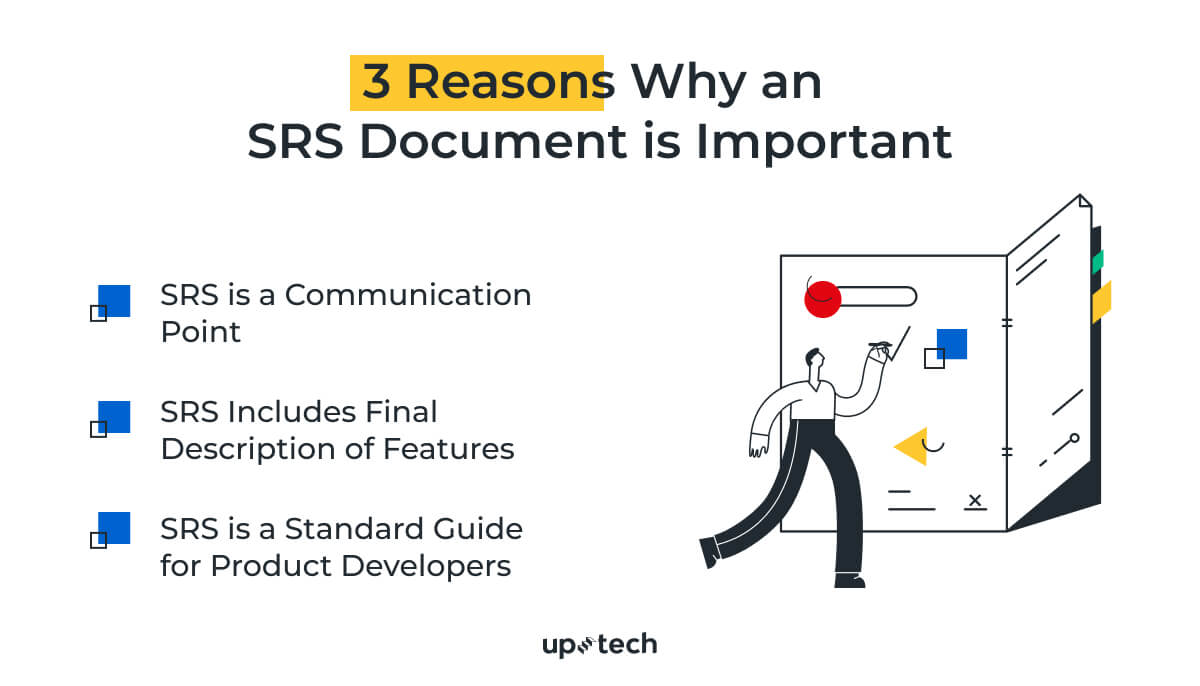Software specification documents are sometimes seen as artifacts that only make sense for developers. However, an SRS can go further and become a guide for marketing specialists, stakeholders, design teams, and even users.
This article will explain why software documentation matters and how to write your SRS to make it a practical guide for all team specialists.
What is an SRS and Why Does it Matter?
An SRS (software requirement specification) document is an artefact that contains the requirements, expectations, and standards for a future product. It may cover text documents, spreadsheets, schemes, precedents, and other elements that clarify the product's vision. In other words, an SRS provides a detailed description of how a product should work and how the product development team should implement it.
Imagine it like building a ship. You have a vision of the mast or sail, and you can even imagine how it travels through the waves. However, you need stricter details to put the ship on the water.
The same applies for product development. You can have a clear vision of an app you want to build with all the features, design elements, and buttons. However, a verbal description of features is not enough for developers to implement the idea.
For the result to match the picture in your head, you need to explain on paper exactly how a feature should function. An SRS is an excellent instrument for describing such technical details.
Who Writes an SRS?
Writing an SRS document means transferring generic descriptions of features, tasks, and goals to the detailed plan of their technical implementation.
SRS are usually written by product and project managers or business analysts, who directly communicate with clients or who do user research (who also works on wireframes and know how the product should behave) and gather future products' requirements.
Meanwhile, this document. A good SRS is not solely technical, as it also covers business goals, metrics, user problems, user personas, etc.
3 Reasons Why an SRS is Important
So, the overall value of an SRS is clear. Here are the reasons why software requirements specification documents are essential:

1. SRS is a Communication Point
As a living document, an SRS document serves as a communication platform between all the specialists: developers, marketing specialists, and co-founders.
By explaining details in an SRS document, formally or informally, managers agree with clients about the results' expectations. Meanwhile, if the changes are made to the requirements, a client and/or a product owner may check and validate them in the document. And the developers are responsible for living up to these expectations.
2. Final Description of Features
SRS the final versions of software that came from the assumptions discussed with clients before. During meetings and calls, user tests, and interviews, the product versions can change very often. Sometimes even product managers can get overwhelmed by the existing product iterations. SRS file helps to unify all these requirements into one standard and eliminate any confusion regarding the product requirements.
3. SRS is a Standard Guide for Product Developers
Besides describing the product requirements, the SRS guides the development team about the steps they should follow to build a product that a client wants.
Depending on the project's organization, developers can or cannot be involved in the project's analytical part. In either case, they need to conclude how the system should function, define the requirements and code parameters to suit it.
Similarly, QA professionals need to understand all the technical aspects that lie behind the product's concept. Thus, SRS documentation serves as a standard for planning and running QA tests.
Finally, designers get project insights through SRS to match the design to the use case.
6 Steps to Writing Good SRS
Functional and non-functional requirements take a large part of any SRS. Product managers do not simply take these requirements from nowhere. They are the result of accurate communications with clients and in-depth user and technical research. Here are the main steps of writing excellent SRS documentation:

Step 1. Communication with a stakeholder
We remove the first layer of uncertainty by asking the stakeholders about their expectations from the product. Sure, such an interview gives just a little understanding of the requirements. However, this is still a great starting point for research.
At Uptech we firstly talk to the client at the Pre-Sale and Kick-Off call when trying to figure out if we fit each other. We try to crystalize the slightest details about the client to understands his/her idea.
Yet, simple communication does not give enough information about the target audience of the product and their wants and needs. So we go on with the discovery stage to make it clear.
Step 2. Discovery Stage
The Discovery stage is critical in writing SRS documentation. At this stage, we have an opportunity to explore the problem that the product should solve, interests, and needs. Our goal here is to identify users' problems and define hypotheses of possible solutions to tackle them. With such an approach, we can make the app valuable to the user.
Use Cases vs User Stories
All user data becomes a part of an SRS document as Use Cases and User Stories. The difference between these two categories is widely debated amongst the product development community.
Simply put, user stories are more focused on the result and benefits a user gets while using a feature. Whereas use cases more granularly describe the function itself.
For example, after multiple user interviews at the Yaza project, we concluded that the app should have a chat. So the user story for such a case would sound like: “As a user, I want to chat with a potential house owner.”
Meanwhile, the use case for this story would describe each step of a user for accomplishing this goal – “As a user, I need to add a contact in my chat list and send him/her a message, so that…”.
Step 3. Build the Structure
Once the discovery is completed, we go on to write SRS documentation. Firstly, we need a brief structure of the document. The content of an SRS may vary significantly, but the typical SRS documentation structure would look like this:
1. Introduction
The intro lays out a summary of the document’s content. It is supposed to answer the following questions:
- Short description of the document’s contents;
- The intended readers of this document;
- The idea of the software you are developing;
- Intended readers.
1.1 Business Goals
Set up a list of goals you want to achieve on the project, like creating an MVP, create a multiplatform mobile app, or launch a website.
Besides, this section should reflect the objectives and success metrics of your business. Though some may exclude this part from the document, it is essential to indicate these things, as they directly influence research and development.
1.2 Intended Use
How do you imagine an individual will use your product? What are the functions you are providing for this type of use? Describe all the possible ways a person can use your product in whatever user role he/she acts.
1.3 Scope
This part will describe the scope of work you need to perform to bring your idea to life.
1.4 Definitions and Acronyms
This one will lay out the definitions of the terms you are using in the document to ensure a complete understanding by the users.
2. Overall Description
Here is the part where you explain the app’s idea, where it came from and why it can be interesting for users.
2.1 User Needs
A piece of software that is built for everyone serves no one. But if you know exactly who your target audience is, where they work, and their pains, you'll have higher chances of delivering an app that's widely adopted by the users.
3. System Features and Requirements
Now it is time to outline the technical requirements of your future software. Describe the features that your product will include, along with the standards that define the quality of these products.
3.1 Functional Requirements
Functional requirements are system specifications, without which the software will not function properly. The definition you will give to your software features will determine how they will be further implemented.
3.2 Nonfunctional Requirements
Whereas functional requirements define what the system's function will be, non-functional requirements determine how the system will implement these features, for example, the speed of completion.
3.3 Tech Stack
A tech stack is a pool of technical solutions used to create and run software or a project. It is critical to indicate it in the SRS as it defines all other technical details.
Step 4. Make a General Description
Before plunging into your product's details, give a general overview of the app’s main features. Simply explain your app's purpose, its features, and how they solve the user’s problem.
Step 5. Define Functional and Non-Functional Requirements
The core of your SRS will usually consist of the product's functional and non-functional requirements. With such specifications, you add more detail to the general overview and thus guide the team through your app's technical specifics.
The difference between functional and non-functional requirements is another sticking point in the product development community. We have shared our expertise on this topic in this article.
Step 6. Make Sure the Client On the Same Page
Approval is a much-anticipated part of web or mobile application development. However, client’s edits can sometimes negate the whole amount of work, completed at a certain point in the project.
To avoid the pressure, we recommend agreeing to small parts of completed SRS documentation, rather than submitting a whole package of at once. This helps to fix certain issues quickly and is less troublesome.
Expert Tips on Writing Great SRS Documentation

It takes time to hone the skill of writing excellent SRS documentation. We have pulled a list of expert tips on writing SRS documentation from our experience. So here are a few insights that will make your SRS documentation effective:
Make It Simple
This is hardly a secret, but simple things rule the world. This is certainly true for any type of documentation you are working at. Your SRS is a unified description of the future product for your whole team. This means that the language, structure and formulations of your SRS should be as laconic as possible.
Include Business Goals
Though an SRS primarily focuses on the tech characteristics, including business objectives is a good practice. An SRS is an instruction for the development team and the product summary for non-tech specialists related to the product. Moreover, including business requirements, like metrics and purposes, will make your SRS a unified instrument for the whole team.
Add User Data
The discovery stage usually unveils the most valuable information about a user. Adding this information to the SRS will make it a helpful paper for the design and development team.
Treat Your SRS as a Living Document
The SRS shouldn't be static, even if you have compiled all the necessary packages for your project. In Agile ecosystems, projects go round acquiring new features with every passing iteration. All such amendments and modifications should be conveyed in the SRS document and agreed with the client.

Conclusion
Writing SRS takes profound research, analysis, and effort. However, a comprehensive SRS that covers business characteristics, technical details, and user data will pay off with a stunning product that meets both client and users' expectations.
Uptech has five years of experience building products for thriving startups. We know how to explore the user's needs and make SRS an effective project management instrument rather than a stack of dust-covered papers.
FAQ
What is SRS?
An SRS is a document covering a detailed description of the technical specifications and requirements of an app or software. An SRS also instructs developers on how to implement the product’s idea to match the client’s expectations.
What is the purpose of an SRS?
The purpose of an SRS is to give technical description of a product's features, provide technical and non-technical requirements and guide the development team on the implementation.
Who Writes SRS?
Depending on the team’s composition, SRS documents are usually written by:
- Product Manager;
- Project Manager;
- Business Analyst;
- Technical Engineer.


































































































.avif)

